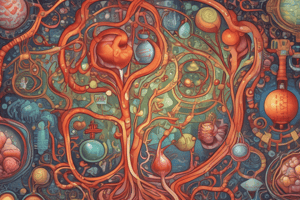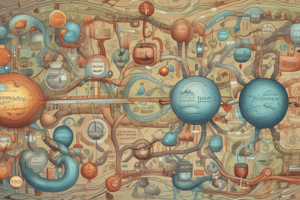Podcast
Questions and Answers
Which of the following statements best describes the relationship between anabolism and catabolism?
Which of the following statements best describes the relationship between anabolism and catabolism?
- Anabolism and catabolism both involve the breakdown of larger molecules.
- Anabolism involves the breakdown of larger molecules, while catabolism involves the synthesis of larger molecules.
- Anabolism and catabolism both involve the synthesis of larger molecules.
- Anabolism involves the synthesis of larger molecules, while catabolism involves the breakdown of larger molecules. (correct)
Excess glucose in the body is directly eliminated through urine without being converted into glycogen or fat.
Excess glucose in the body is directly eliminated through urine without being converted into glycogen or fat.
False (B)
What is the primary role of glucose in the body's metabolism?
What is the primary role of glucose in the body's metabolism?
Fuel for ATP production
The process by which triglycerides are broken down into glycerol and fatty acids is called ______.
The process by which triglycerides are broken down into glycerol and fatty acids is called ______.
Match each lipid with its primary function in the body:
Match each lipid with its primary function in the body:
Which of the following is NOT a primary dietary source of carbohydrates?
Which of the following is NOT a primary dietary source of carbohydrates?
The liver synthesizes approximately 25% of the body's cholesterol, while dietary intake accounts for the remaining 75%.
The liver synthesizes approximately 25% of the body's cholesterol, while dietary intake accounts for the remaining 75%.
What is the initial metabolic pathway that glucose undergoes?
What is the initial metabolic pathway that glucose undergoes?
What is the net ATP production from the electron transport chain (ETC) per glucose molecule?
What is the net ATP production from the electron transport chain (ETC) per glucose molecule?
The citric acid cycle occurs in the cytoplasm of the cell.
The citric acid cycle occurs in the cytoplasm of the cell.
What is the final product of glycolysis under anaerobic conditions (no oxygen present)?
What is the final product of glycolysis under anaerobic conditions (no oxygen present)?
In stage 3 of metabolism, H atoms are delivered to molecular oxygen to form ______.
In stage 3 of metabolism, H atoms are delivered to molecular oxygen to form ______.
Which of the following is produced during each turn of the citric acid cycle?
Which of the following is produced during each turn of the citric acid cycle?
Which stage of metabolism involves the breakdown of nutrients into pyruvic acid and acetyl CoA?
Which stage of metabolism involves the breakdown of nutrients into pyruvic acid and acetyl CoA?
Match each nutrient with its absorbable unit after digestion:
Match each nutrient with its absorbable unit after digestion:
The electron transport chain can occur whether or not oxygen is present.
The electron transport chain can occur whether or not oxygen is present.
Which of the following dietary sources is considered a complete protein, containing all needed essential amino acids?
Which of the following dietary sources is considered a complete protein, containing all needed essential amino acids?
If one essential amino acid is missing from the diet, the body can still efficiently synthesize proteins using the remaining amino acids.
If one essential amino acid is missing from the diet, the body can still efficiently synthesize proteins using the remaining amino acids.
Name the structural protein found in skin.
Name the structural protein found in skin.
__________ hormones, such as growth hormone (GH) and sex hormones, accelerate protein synthesis and growth.
__________ hormones, such as growth hormone (GH) and sex hormones, accelerate protein synthesis and growth.
What is the process of breaking down proteins into amino acids called?
What is the process of breaking down proteins into amino acids called?
In cellular respiration, which process is utilized by carbohydrates only and occurs in the cytosol of cells?
In cellular respiration, which process is utilized by carbohydrates only and occurs in the cytosol of cells?
Glycolysis requires oxygen to convert glucose to pyruvic acid.
Glycolysis requires oxygen to convert glucose to pyruvic acid.
What is the net ATP production from one molecule of glucose undergoing glycolysis?
What is the net ATP production from one molecule of glucose undergoing glycolysis?
Why is lipid metabolism key for long-term energy storage and release?
Why is lipid metabolism key for long-term energy storage and release?
Protein metabolism is the most efficient pathway for energy production.
Protein metabolism is the most efficient pathway for energy production.
What is the process called in which fatty acids are liberated?
What is the process called in which fatty acids are liberated?
After fatty acids are liberated, they are converted to ______ and enter the citric acid cycle to be made into ATP.
After fatty acids are liberated, they are converted to ______ and enter the citric acid cycle to be made into ATP.
Match the following molecules with their metabolic fate, according to Figure 24.19:
Match the following molecules with their metabolic fate, according to Figure 24.19:
During cellular respiration, if oxygen is not present, what is pyruvic acid converted into?
During cellular respiration, if oxygen is not present, what is pyruvic acid converted into?
The net ATP yield from glycolysis, through substrate-level phosphorylation, is 4 ATP.
The net ATP yield from glycolysis, through substrate-level phosphorylation, is 4 ATP.
How many NADH + H+ molecules are produced from the citric acid cycle per glucose molecule?
How many NADH + H+ molecules are produced from the citric acid cycle per glucose molecule?
Triglyceride is composed of a glycerol backbone and three ______.
Triglyceride is composed of a glycerol backbone and three ______.
Match each process with its net ATP production method:
Match each process with its net ATP production method:
What is the approximate ATP yield per glucose molecule through oxidative phosphorylation?
What is the approximate ATP yield per glucose molecule through oxidative phosphorylation?
What is the purpose of the electron transport chain?
What is the purpose of the electron transport chain?
How many ATP molecules are produced per FADH2 molecule in the electron transport chain?
How many ATP molecules are produced per FADH2 molecule in the electron transport chain?
Flashcards
Metabolism
Metabolism
The sum of all biochemical reactions inside a cell involving nutrients.
Anabolism
Anabolism
Reactions that build larger molecules from smaller ones (synthesis).
Catabolism
Catabolism
Reactions that break down larger molecules into smaller ones (decomposition).
Glucose
Glucose
Signup and view all the flashcards
Glycolysis
Glycolysis
Signup and view all the flashcards
Triglycerides
Triglycerides
Signup and view all the flashcards
Lipolysis
Lipolysis
Signup and view all the flashcards
Cholesterol
Cholesterol
Signup and view all the flashcards
Lactic Acid
Lactic Acid
Signup and view all the flashcards
Mitochondria
Mitochondria
Signup and view all the flashcards
Citric Acid Cycle Products
Citric Acid Cycle Products
Signup and view all the flashcards
Electron Transport Chain (ETC)
Electron Transport Chain (ETC)
Signup and view all the flashcards
Total ATP Yield
Total ATP Yield
Signup and view all the flashcards
Stage 1: GI Tract
Stage 1: GI Tract
Signup and view all the flashcards
Stage 2: Tissue Cells
Stage 2: Tissue Cells
Signup and view all the flashcards
Stage 3: Mitochondria
Stage 3: Mitochondria
Signup and view all the flashcards
Complete Proteins
Complete Proteins
Signup and view all the flashcards
Incomplete Proteins
Incomplete Proteins
Signup and view all the flashcards
Protein Uses in Body
Protein Uses in Body
Signup and view all the flashcards
All-or-None Rule
All-or-None Rule
Signup and view all the flashcards
Adequacy of Caloric Intake
Adequacy of Caloric Intake
Signup and view all the flashcards
Hormonal Controls
Hormonal Controls
Signup and view all the flashcards
Water in Cellular Respiration
Water in Cellular Respiration
Signup and view all the flashcards
Catabolic Reactions
Catabolic Reactions
Signup and view all the flashcards
Anabolic Reactions
Anabolic Reactions
Signup and view all the flashcards
Electron Transport Chain
Electron Transport Chain
Signup and view all the flashcards
Acetyl CoA
Acetyl CoA
Signup and view all the flashcards
Citric Acid Cycle
Citric Acid Cycle
Signup and view all the flashcards
Fate of Pyruvic Acid (without oxygen)
Fate of Pyruvic Acid (without oxygen)
Signup and view all the flashcards
What is Lipolysis?
What is Lipolysis?
Signup and view all the flashcards
What happens to glycerol and fatty acids after lipolysis?
What happens to glycerol and fatty acids after lipolysis?
Signup and view all the flashcards
Why is lipid metabolism important?
Why is lipid metabolism important?
Signup and view all the flashcards
Why are proteins not a good primary energy source?
Why are proteins not a good primary energy source?
Signup and view all the flashcards
Do fatty acids or glucose produce more ATP?
Do fatty acids or glucose produce more ATP?
Signup and view all the flashcards




